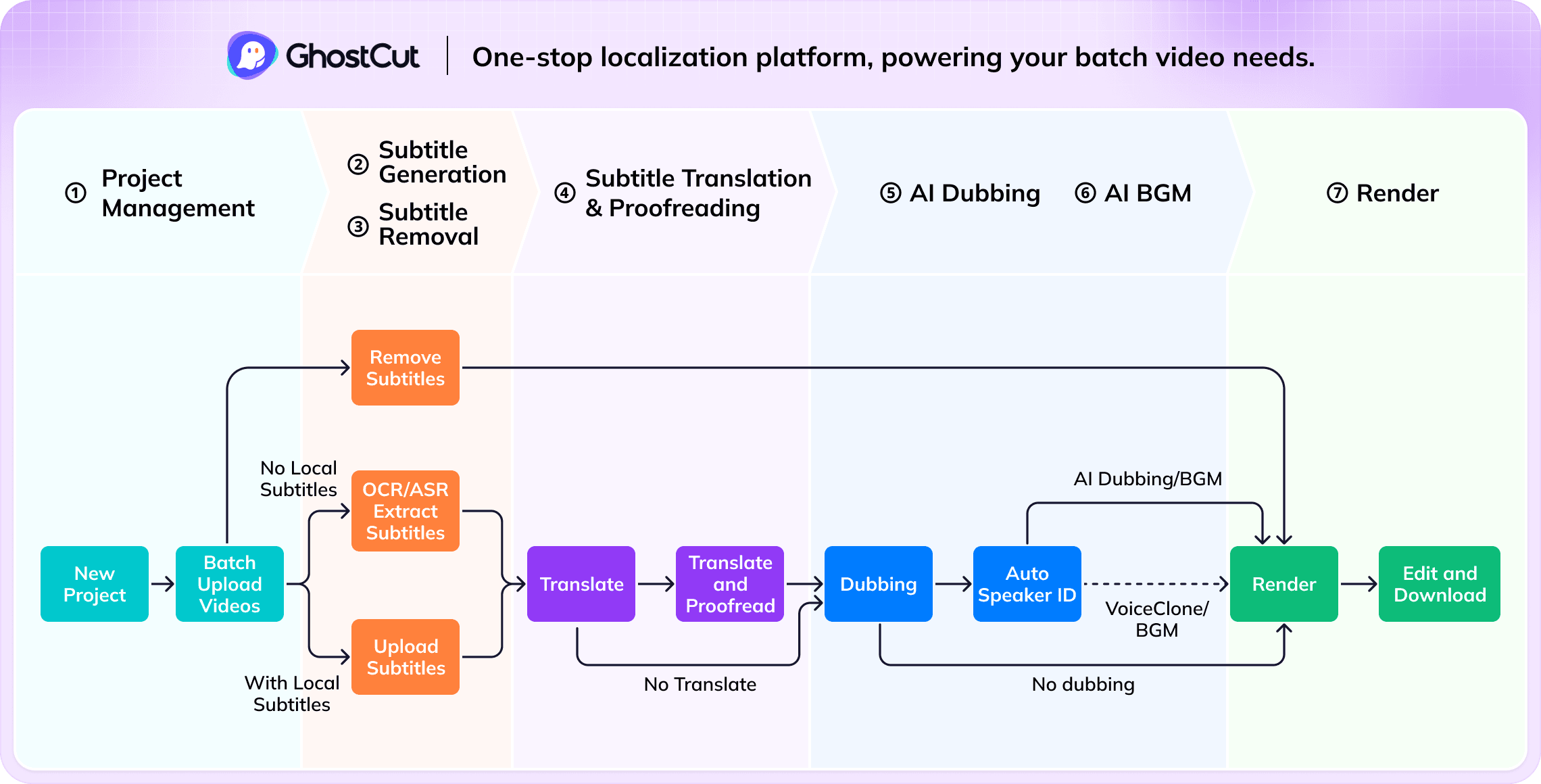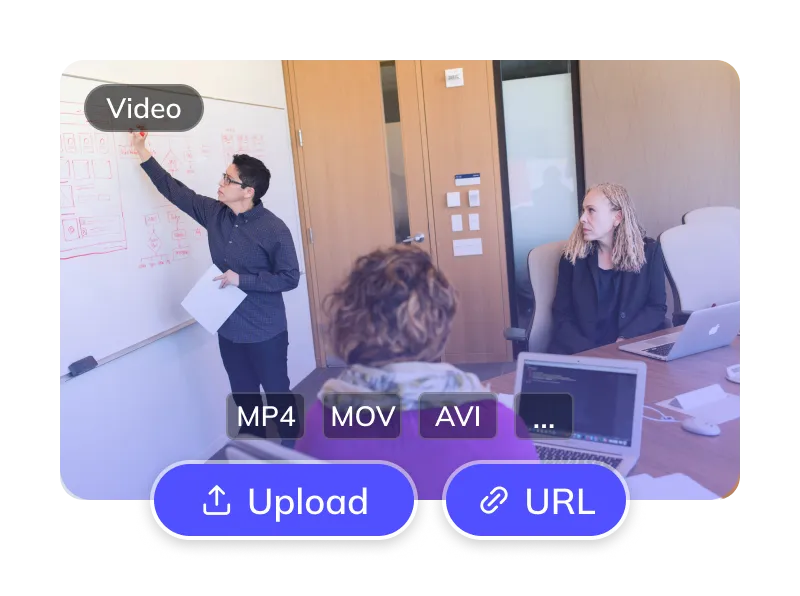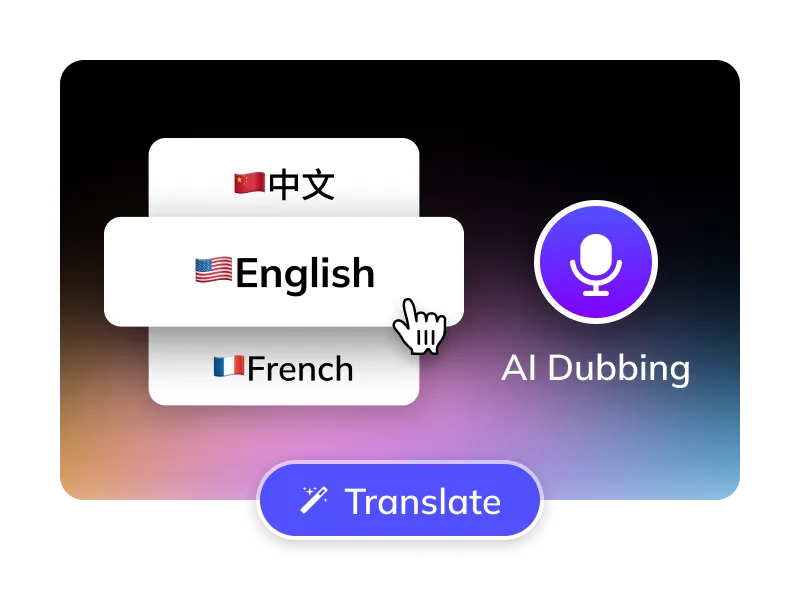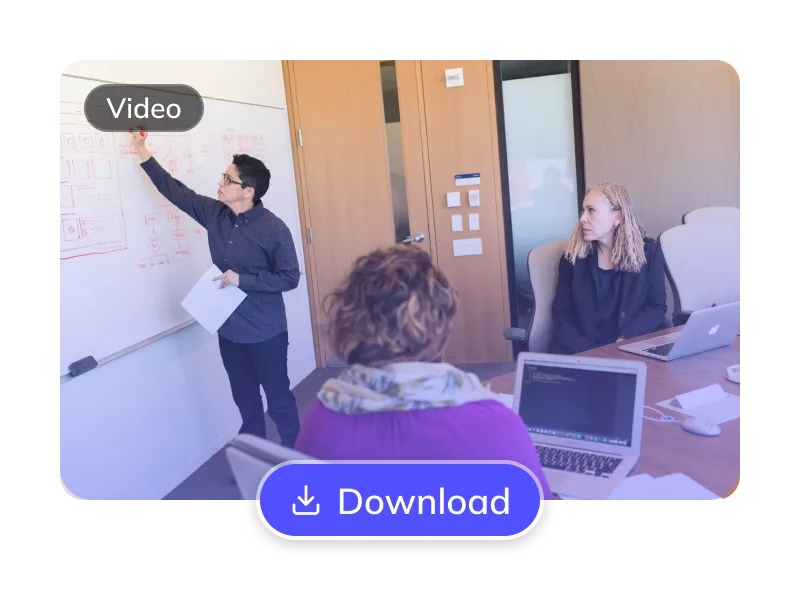How to Translate Chinese Videos to English ?
Translate Chinese Videos to Thai in 3 Easy Steps
Trusted by 1,500,000+ Global Creators and Businesses
Why GhostCut for Your Video Translations?
GhostCut is your all-in-one AI solution for translating Chinese content into natural, engaging Thai.
Effortless Project Management
Manage Chinese assets, subtitles, & Thai videos. Batch process projects efficiently.
Pinpoint Thai Accuracy
Up to 99.5% accurate. Optimized for Chinese-to-Thai with LLM calibration & multi-agent review for culturally fluent Thai translations.
Lifelike Thai AI Dubbing
Choose from diverse, human-like Thai AI voices (US/UK accents). Emotion-cloning technology captures original tone for natural Thai delivery.
Flexible Chinese Subtitle Options
Optionally erase original Chinese hardsubs for a clean slate. Translate embedded Chinese subtitles directly.
Smart Multi-Speaker ID (Chinese)
AI detects multiple speakers in Chinese videos. Assign or clone distinct Thai voices per character, with cross-episode consistency for complex Thai dubs (dramas, interviews).
Efficient Batch Processing & API
Batch translate and dub 100s of Chinese videos to Thai at once. Seamlessly integrate with our robust API.
Versatile BGM Control
Keep or mute original BGM. Our unique tech can also isolate sound effects, meeting diverse copyright and distribution needs.
Unbeatable Value
Flexible Chinese-to-Thai plans. Try core features free. Automated pro service from just $0.1/minute.
Easy Online Access
No downloads. Instantly translate Chinese videos to Thai online. Works on Windows, Mac, & major mobile browsers for cloud processing anywhere.
The GhostCut Edge: Unmatched Accuracy, Speed, and Value.
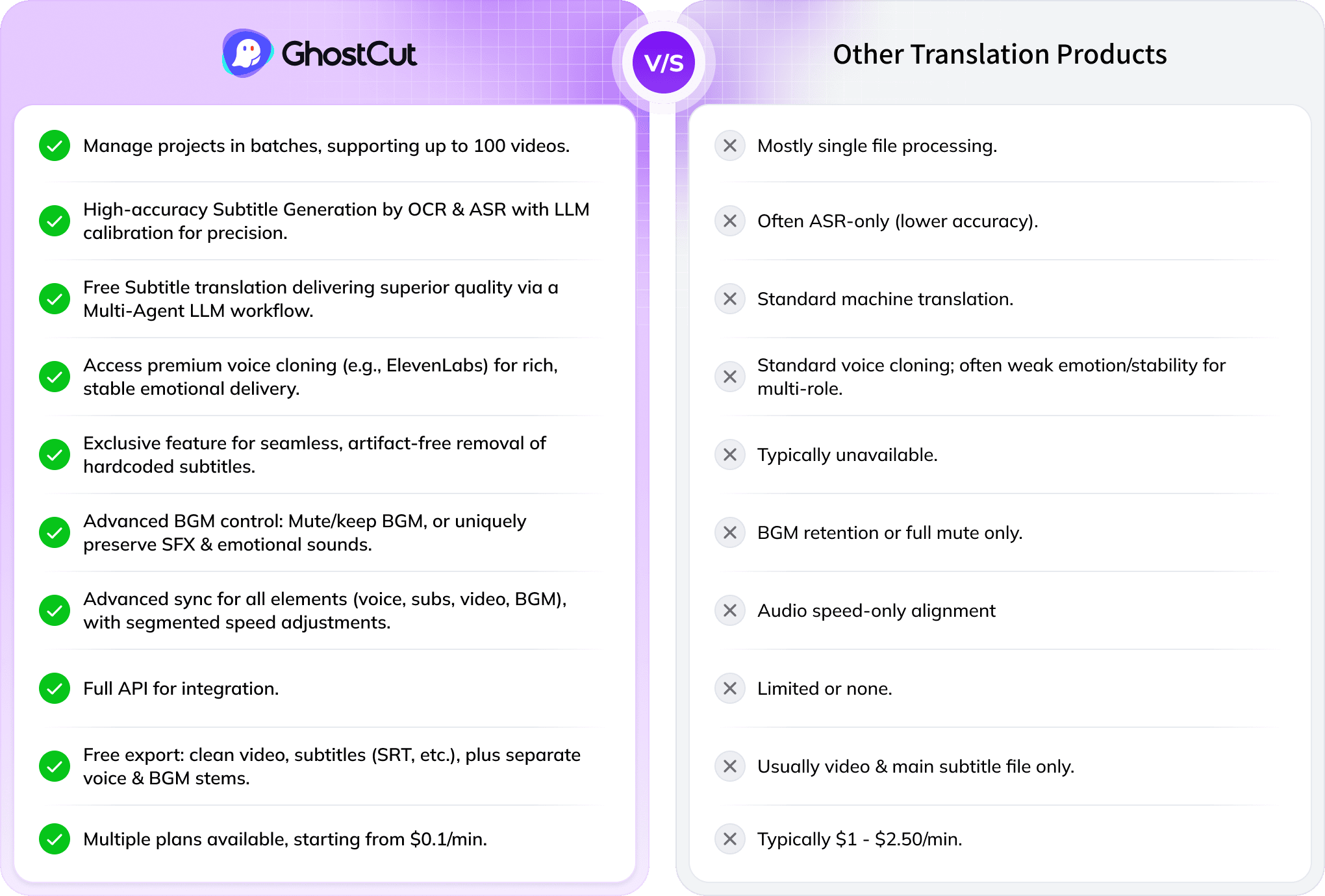
Every Algorithmic Optimization, Engineered for Quality Thai Video
Mastering Long-Form Chinese Drama & Multi-Character Dubbing
Translating a 100-minute Chinese drama with 4000+ lines and many characters into Thai is tough. Standard AI struggles to tell speakers apart, causing errors. GhostCut’s multi-modal AI (video, voice, text) excels in long-form, multi-speaker content, ensuring accurate, consistent character voices across entire series.
Translate Now

Seamless Thai Dubbing & Perfect Lip-Sync
GhostCut ensures natural Thai audio flow by treating related subtitles as whole ideas for TTS. It then precisely times new Thai subtitles. Since Chinese-to-Thai translation can change speech length, our AI expertly adjusts the new Thai audio, subtitles, video, and BGM to maintain perfect sync, just like a seasoned editor.
Translate NowBoost ROI with Flawless Chinese Subtitle Removal
Original Chinese hardsubs can limit your video's global appeal. GhostCut’s AI doesn't just blur; it intelligently reconstructs the background obscured by Chinese subtitles, even complex ones, for a perfectly clean, high-quality visual. This means better viewer engagement, longer watch times, and higher ROI.
Translate Now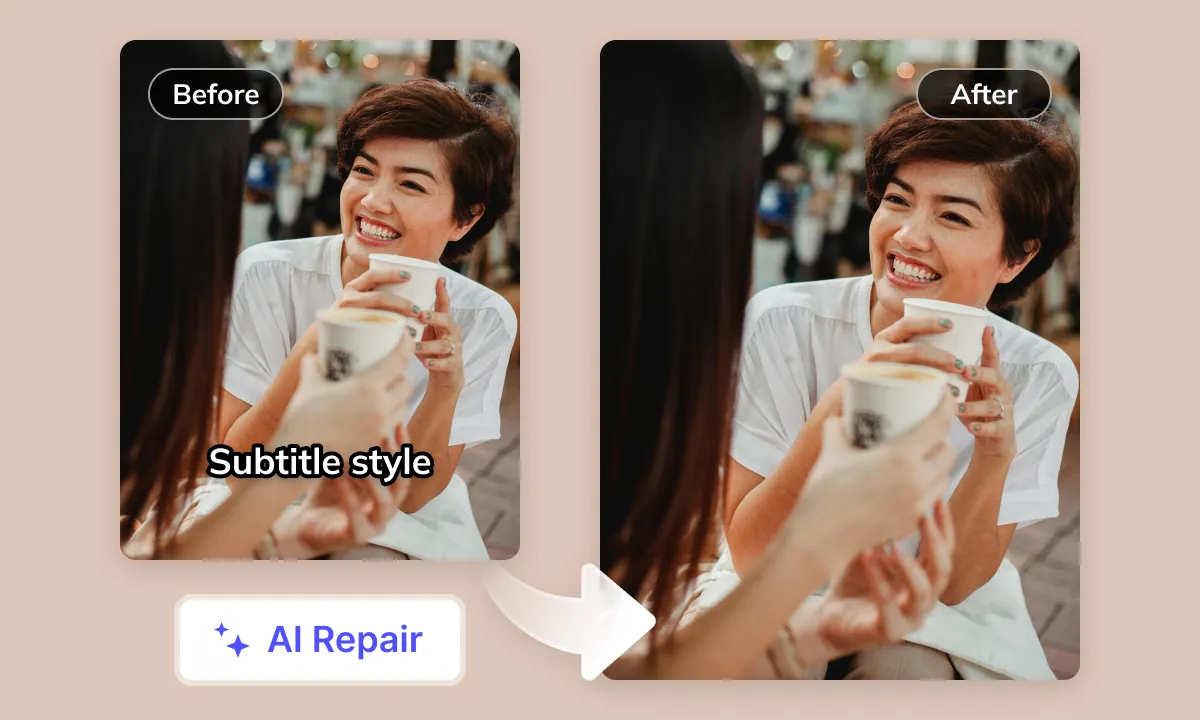

Smart Audio Control for YouTube Creators
Navigating BGM copyright on YouTube is tricky. GhostCut’s advanced audio separation isolates Chinese dialogue for translation, while intelligently managing BGM, sound effects, and even emotional expressions. Our "Keep SFX, Remove Music" option is a creator favorite for avoiding copyright issues without losing your video’s impact.
Translate NowSeamlessly Bring Your Chinese Videos to the Thai World
High-quality Chinese videos, from dramas and food vlogs to deeper content, are attracting global attention but face language barriers entering the Thai market. Lack of professional Chinese-to-Thai translation and dubbing prevents these engaging videos from being understood and accepted by Thai audiences. This limits their reach, influence, and audience engagement. To overcome these barriers and reach Thai viewers, the market urgently needs efficient, reliable AI Chinese-to-Thai video translation and dubbing technology
Chinese to Thai Translation: Challenges and Considerations
Handling Source Media: Subtitles Audio
For video content, improperly handled original Chinese hardcoded subtitles or audio can significantly hinder comprehension and viewing fluency for Thai audiences. It's crucial to gracefully remove or replace these elements to prioritize the presentation of the Thai translated content
Language Structure Cultural Differences: Bridging Gaps
Chinese linguistic structure, expressions, and rich cultural nuances differ significantly from Thai. Direct translation of idioms, proverbs, word order, and culturally specific vocabulary is often ineffective. A key challenge in Chinese to Thai translation is accurately and naturally conveying the essence of the original text in Thai
Thai Subtitle Layout: Space Readability
Unlike the compact nature of Chinese characters, Thai script (including tone marks, vowels, and other diacritics) typically requires more vertical and horizontal space. When translating Chinese content into Thai subtitles, meticulous re-typesetting is essential. This involves carefully controlling line length and breaks to ensure subtitles are clear, legible, and not overcrowded
Pacing Synchronization: Audio-Visual Harmony
Chinese often has a faster speaking pace and higher information density. When dubbing into Thai, the time required to convey the same content may differ. This poses a challenge for audio-visual synchronization, necessitating precise adjustments to the Thai voiceover's pacing and pauses to align closely with the original video's visual rhythm
Chinese Speech Recognition: Accuracy Challenges
For content originating from Chinese audio or video, accurate Chinese speech recognition is the initial step in the translation process. However, factors like dialects, overlapping multi-speaker dialogue, and complex background noise remain significant challenges affecting AI recognition accuracy
Thai AI Voice Quality: Naturalness Emotion
Despite advancements in Thai AI voice technology and an increasing selection of voice options, finding high-quality AI voices that sound natural, have rich intonation, and accurately convey emotion remains difficult. Many AI voices still sound robotic or lack expressiveness
Lip-Sync: Cross-Language Difficulty
Chinese and Thai have distinct pronunciation methods and corresponding mouth shapes. Achieving a high degree of lip synchronization between Thai voiceovers and the original video's character mouth movements is a highly technical and demanding task, especially noticeable in close-up shots
Ideal Chinese to Thai Translation Standards
Ideal Chinese to Thai AI translation should meet the following standards: accurate Chinese speech recognition - authentic and contextually appropriate Thai translation (effectively addressing linguistic and cultural differences) - high-quality Thai AI voiceover (striving for lip and visual synchronization) - automated intelligent integration and presentation of audio-visual content
Tackling Video Translation Challenges with AI Empowering your Chinese content for any worldwide scenario.
Your All-in-One AI Translation Studio
GhostCut offers more than just Chinese-to-Thai translation. It's a complete AI-powered workflow: subtitle extraction 、 removal 、 translation and proofreading to multi-character dubbing , BGM processing, and final rendering. Go from Chinese source to global-ready videos, effortlessly.
